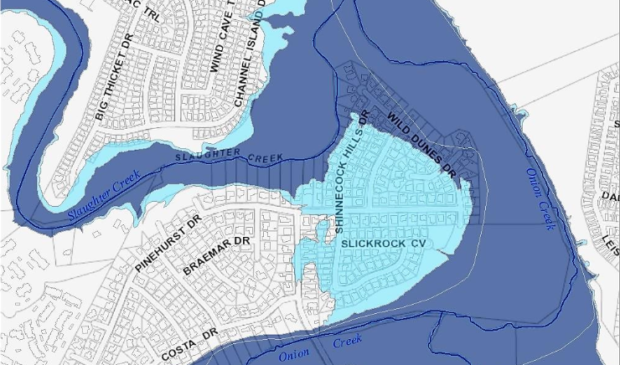Council approves amendments to city code and new floodplain maps
Monday, November 18, 2019 by
Jessi Devenyns City Council has unanimously approved amendments to the city code redefining what constitutes the 25-year and 100-year floodplains in Austin. The changes also amend floodplain regulations and expand staff’s ability to approve residential redevelopment within the expanded floodplains.
The proposed code changes are the result of Atlas 14, a historical rainfall study released by the National Weather Service in 2017. The data in the study – the first to occur in decades – showed that Austin is projected to receive a 30 percent increase in rainfall in the coming years, dramatically altering the city’s floodplains.
“We are fortunate to live in a community that acknowledges climate change is real,” said Council Member Paige Ellis, who joined other Council members in praising the Watershed Protection Department for proactively addressing Austin’s increased flood risk.
Austin’s new floodplains will be temporarily redefined using the pre-Atlas 14 500-year floodplain to define the new 100-year floodplain, and pre-Atlas 14 100-year floodplain as the 25-year floodplain.
Kevin Shunk, the city’s floodplain administrator, told Council that these interim definitions will remain in place for two to three years while the Watershed Protection Department redefines its flood maps with permanent boundaries. He explained that while the department is conducting the necessary studies, the Atlas 14 data show that this substitution provides a good approximation.
Expanding the floodplains using the interim definitions will put 3,200 new buildings in the floodplain. Overall, this translates to 3 percent of buildings in the entire city that will be in the new 100-year floodplain.
Currently, those who own homes in a floodplain need to comply with floodplain regulations if they want to add on or renovate, unless they are given a Council-approved exception. In hopes of limiting the number of residential applicants looking for a special exception from Council, Watershed Protection proposed expanding the redevelopment exception whereby city staff could administratively approve redevelopment projects.
The revised ordinance allows for administrative exceptions if the floor of the entire building is 2 feet above the ground, the development does not increase the number of dwelling units on the property and if the development does not cause adverse flooding to other properties.
Also among the approved changes is an exception allowing staff to administratively approve an application for a small addition that satisfies the same requirements as a full redevelopment. This exception does not apply to substantial improvements, which the department defines as being worth 50 percent or more than the value of the entire home, not including the cost of land.
“We think this is a significant step in responding to the new flood risk we have here in Austin,” Shunk said, adding that it is only the first step.
In April, Watershed Protection hopes to return to City Council with language and processes for reevaluating redevelopment exceptions for the commercial buildings that will be in the expanded floodplains.
While city staffers continue their work informing the public about changes in the floodplains and the new definitions, Shunk encouraged anyone who will be within the new flood areas to look into getting flood insurance. “Please get a quote on flood insurance. Understand your flood risk,” he said.
According to Shunk, it will take about five years for Austin’s new floodplain maps to make it all the way up to FEMA, where the government will adjust the flood insurance rate maps. Getting flood insurance prior to that, he explained, gives residents a good chance of obtaining a cheaper rate that will be grandfathered in going forward.
Map courtesy of the city of Austin.
The Austin Monitor’s work is made possible by donations from the community. Though our reporting covers donors from time to time, we are careful to keep business and editorial efforts separate while maintaining transparency. A complete list of donors is available here, and our code of ethics is explained here.
You're a community leader
And we’re honored you look to us for serious, in-depth news. You know a strong community needs local and dedicated watchdog reporting. We’re here for you and that won’t change. Now will you take the powerful next step and support our nonprofit news organization?



